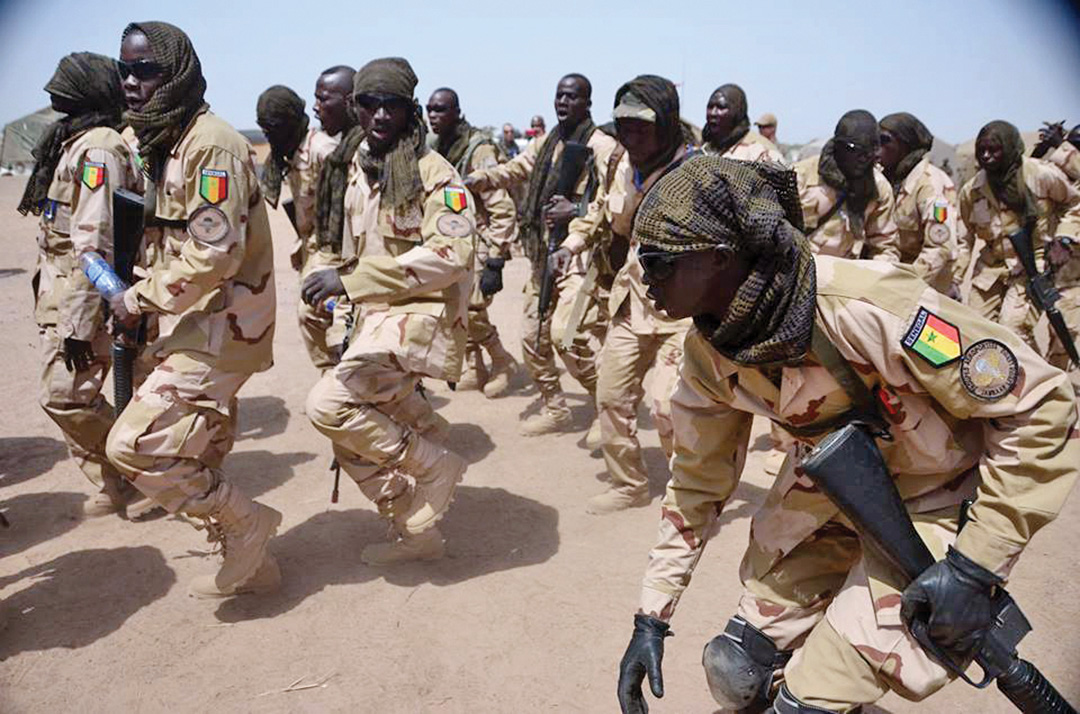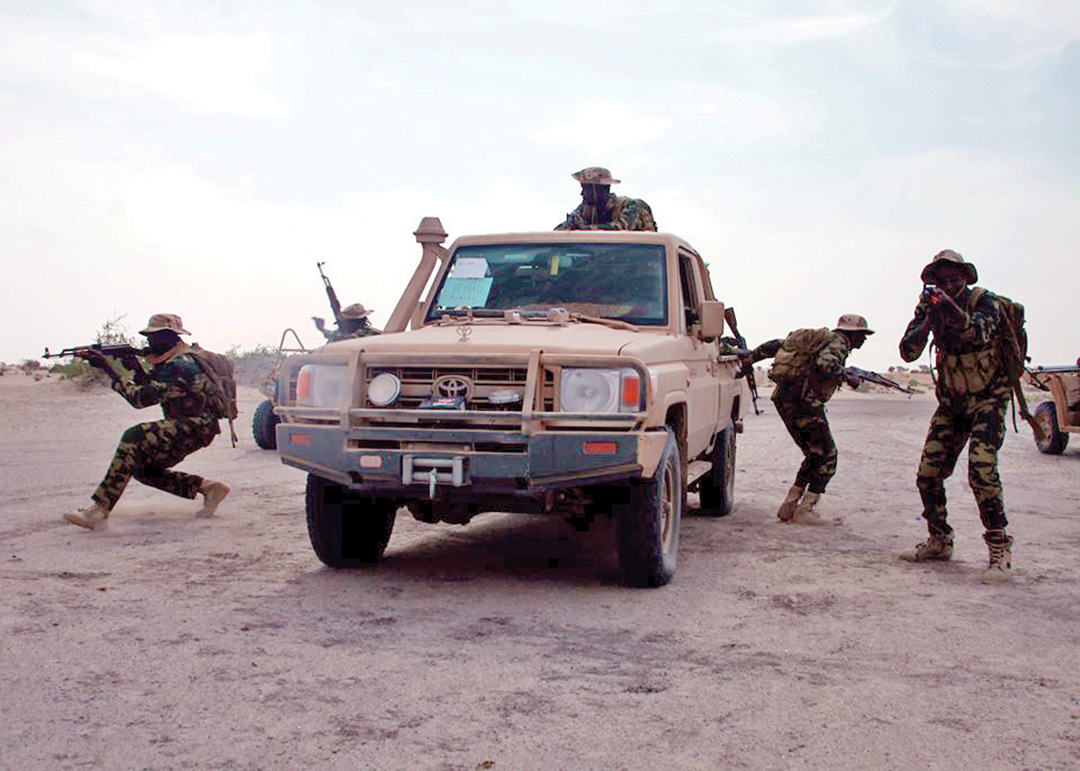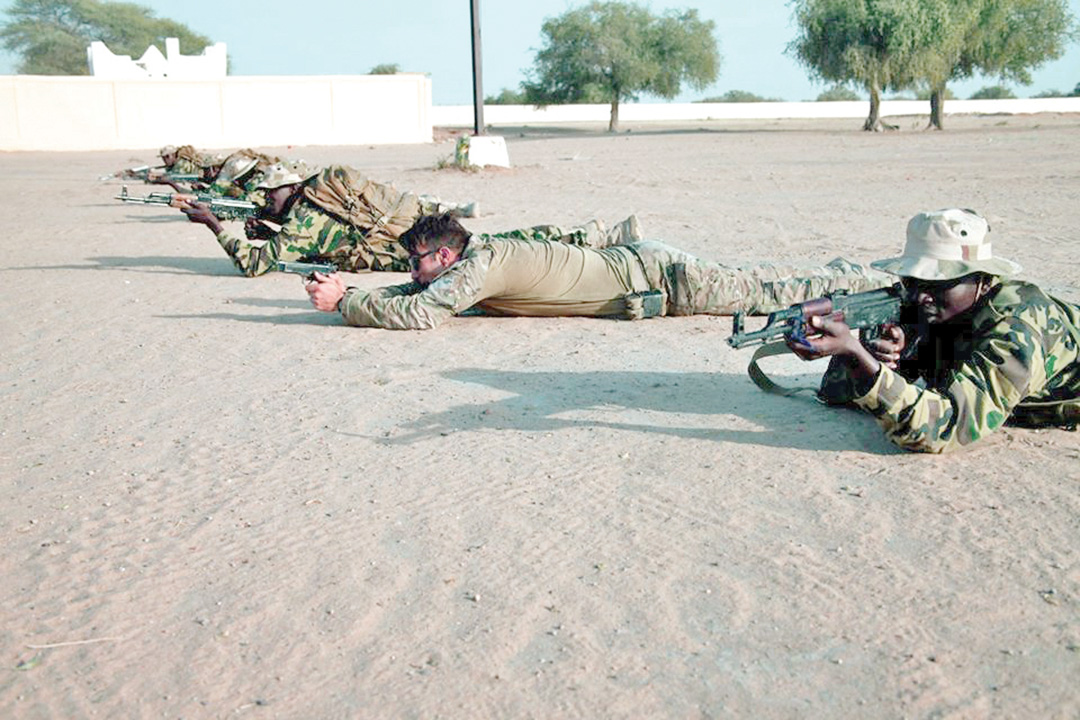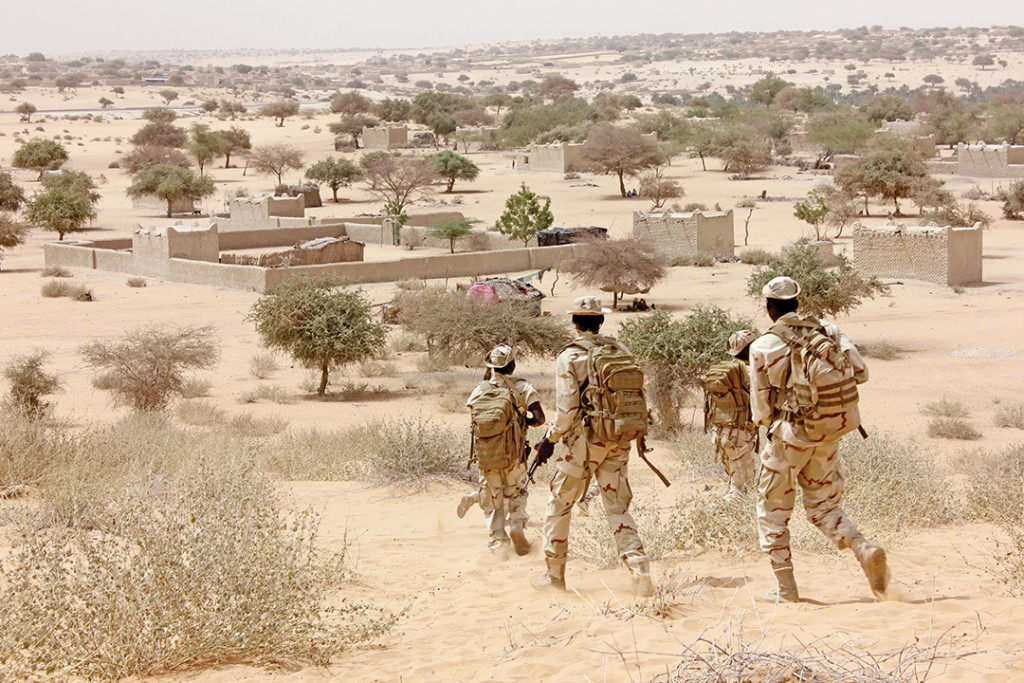Flintlock 2015 helps the Lake Chad region unite to fight Boko Haram
For nearly a decade, special operations Soldiers have gathered in the Sahel for Flintlock, the annual exercise designed to build partnerships and share tactics needed to rid the region of extremists and traffickers.
Flintlock 2015 was different. It involved a real and nearby threat: the extremist group Boko Haram. In fact, the Flintlock closing ceremony near N’Djamena, Chad, on March 9, 2015, was conducted as ground and air forces from Niger and Chad launched an offensive in northeastern Nigeria to dislodge the terror group from its stronghold.
Since its inception, Flintlock has never focused on any specific security threat or group. The intent has been to develop security capacity, build professionalism and craft lasting bonds among participating countries. The exercise has been about overcoming cultural, professional and technical barriers, be they language, fighting techniques, radio systems or customs.
In 2015, the largest Flintlock ever, host nation Chad had to deal with the terrorist organization Boko Haram in addition to the scheduled training. The singularity of the situation was not lost on anyone.

Experienced trainers said the mindset for Flintlock 2015 was different from past years. There was always a sense at other exercises, one military observer said, that they were training Soldiers to protect their own countries. For Flintlock 2015, there was a sense of training to protect the entire continent and beyond.
“When your neighbor’s house is burning, you have to put it out, because if not, yours is next,” said Chadian Lt. Col. Brahim Mahanat, referring to the threat Boko Haram poses to the region.
On one of the final days of Flintlock, Boko Haram pledged its allegiance to the Islamic State of Iraq and Syria, the notorious extremist group that is occupying parts of Syria, Libya and Iraq. Boko Haram reportedly now refers to itself as the Islamic State’s West African Province.
Much of the training was staged from military posts near Chad’s capital, N’Djamena, little more than 50 kilometers from Boko Haram-held territory in Nigeria. Before the Flintlock training began, Cameroon, Chad and Niger already had dispatched thousands of Soldiers to Nigeria to take on the estimated 4,000 to 6,000 insurgents. The troops reclaimed some of the 30 Nigerian towns controlled by the extremists.
The proximity to an actual threat was not the only reason Chad was a particularly appropriate choice as the Flintlock host. Chadian troops bolstered their reputation internationally in 2013 when they joined French forces in fighting al-Qaida-linked rebels in northern Mali. But trainers noted that many of the Chadian troops, like Soldiers from other African nations, were young and inexperienced. They needed lessons in such basics as adjusting the sights on their rifles and the importance of properly cleaning their weapons.
Chadian Brig. Gen. Zakaria Ngobongue, exercise director for Flintlock 2015, said one of the most important parts of the training was its emphasis on building relationships among African nations. One training scenario involved cross-border fighting with a group modeled after Boko Haram. Other training emphasized using Soldiers from multiple countries, working as teams, and rescuing a village or compound under siege by invaders.
Officers stressed the need for their Soldiers to interact with civilians as often as possible. Ngobongue said his country’s civilians needed to be better informed about security threats so they could help provide Soldiers with information on suspicious groups and activities. Even residents of N’Djamena did not understand the threat of Boko Haram, he said.
“They feel safe on this side of the river,” he said. “We need a campaign to make them aware of the risk.”

TWENTY-THREE COUNTRIES
Nearly 1,300 people from 23 countries took part in the three-week exercise, with training in Chad, as well as Cameroon, Niger, Nigeria and Tunisia. About 700 of the troops were from African nations, with 365 European Soldiers and 250 American commandos participating. Flight crews from Belgium, Canada, Denmark, Germany, Italy, the Netherlands, Spain, Sweden and the United Kingdom moved troops and nearly 230 metric tons of cargo on 113 flights. Each Soldier on the mission received 150 hours of training, and many received new military equipment along with their training.
Exercise trainers emphasized that, by default, Flintlock was largely about tactics and approaches to be used in the future to fight asymmetric threats such as Boko Haram. The training included staged ambushes, rescue missions, shooting practice and patrols. Conditions were hot and dusty in the barren environment of the Sahel, which sits along the southern edge of the Sahara. Sandstorms — typical during February and March — lowered visibility. Some flights were grounded because of the omnipresent powdery sand.
“Given the austere nature of the environment, the lack of any previously established living or operating space, serious logistical complaints, and the participation of multiple nations, this exercise poses an immensely difficult problem,” said one American major involved in logistics.
Preparations started three weeks before the exercise, with organizers arriving in areas offering little more than dirt roads and vast sweeps of sand. Working in the relentless heat and harsh sun, they brought in trucks and forklifts to set up fences, tents and supply depots. Generators provided power and air conditioning.
The heat was such that the meager shade of the occasional thorny acacia tree was never taken for granted. During meals and other off-times, plastic chairs were crowded beneath the scrawny trees to offer some relief from the sun.

MEDICAL AID
To further reinforce civilian-military relations, military personnel provided medical assistance to local residents as part of the training exercise. Medical personnel treated 1,800 people in temporary clinics near Mao, Faya and Moussoro in Chad, and in Agadez, Niger. Medical workers observed that for many of the patients, the clinics were their first exposure to military personnel of any kind during peacetime.
The clinic in Mao was typical. The town of about 18,000 people is barren and, despite having an airport, remote. Some people on hand for the day of medical exercise readiness and training had traveled for days by donkeys and other types of transportation to get medical care. Exercise officials from seven countries, working with UNICEF and local leaders, coordinated medical screenings, treatment of ailments and injuries, and medicine distribution.
Patients were offered a range of services including dentistry, primary care, eye care and women’s health care. Workers made a special effort to observe village and cultural protocols, including having women on hand to work with female patients. In some cases, patients were so ill that they were sent to the small Mao hospital for additional care.
Dental care was in particular demand, with workers pulling teeth, giving basic instructions on oral hygiene, and handing out dental supplies, including toothpaste and toothbrushes.
“We’re prepared to do some tooth extractions, minor fillings and spot cleaning,” U.S. Army Capt. Ross Cook, one of the dentists, told Flintlock staff members. “However, these missions are really more about what you leave behind with the local provider, being able to understand what their primary care needs are, and being able to recommend solutions based on what they regularly have on hand.”
Veterinary help was available for animals. Workers offered antibiotics, vaccinations and wound treatments. In a region where goats and donkeys are a vital part of everyday life, veterinary workers were able to assess herds and suggest ways to improve animal health.
OVERCOMING DISTRUST
The military part of Flintlock included small-unit training with counterterrorism groups. The region’s armies traditionally have not worked well together, partially because of distrust and cultural rivalries, but also because of vast differences in military readiness and communications equipment.
The goal was, as always, to strengthen security institutions and partnerships, promote information and intelligence sharing, and improve interoperability among participating African countries in the Trans-Sahara Counterterrorism Partnership. The partnership helps African governments control their territories and prevent parts of the region from becoming a haven for extremists. There are 20 African partner nations in the initiative.
Most days, each African nation partnered with a Western counterpart for tactical training. The ambush defense training was particularly useful, in light of Boko Haram. Other training included tactical patrol maneuvers and removing wounded Soldiers under fire. The sound of gunfire punctuated the day as troops took target practice.
Foreign trainers marveled at how Soldiers from the region, even weighted down with equipment and running during tactical maneuvers, seemed impervious to the heat.

TALKING TO EACH OTHER
For as long as nations have been working together in military and police exercises, there have been communications problems. Flintlock 2015 sought to bridge some of the gaps.
Often, communications among partnering countries are impossible due to language barriers. With thousands of native dialects divided among six basic language “families” on the continent, even basic face-to-face communications can be a challenge. But there also is the problem of hardware. In years past, multicountry military exercises, and even actual military operations, were hampered by incompatible radios: different systems, different bandwidths, different radios.
Leaders at Flintlock 2015 said cellphones are now revolutionizing military communications in the field. They are enabling countries’ armies and police to communicate with each other without the need for bulky radio systems. But other technologies also are under development.
Some of that development has its origins in two disasters in the United States — the 9/11 terrorists attacks and Hurricane Katrina, which devastated part of the country’s Gulf of Mexico coast. In both instances, first responders struggled to communicate because radios used by different government agencies employed different bandwidths.
Using ordinary electronic components, American engineers developed a system to allow two commonly used bandwidths, UHF and VHF, as well as cellphones, to communicate on a single network. In the field, the system operator can link any device that can send and receive transmissions to communicate with other devices, including cellphones, texting devices, computers and hand-held radios. Operators said the system will give linked armies the ability to communicate in real time, regardless of the kind of gear they are using.
At Flintlock, operators trained Soldiers to use the system in three stages: classrooms, hands-on practice and practical exercises. Trainers said that during the instructions, students repeatedly came up with new ways to use the equipment in the field.
The device itself is about the size of a suitcase and has been designed to withstand rough environments, including the sands of the Sahara. The system underwent real-world testing during the persistent dust storms in Chad.
The central device can be thought of as a wheel hub, with all devices connecting to it being spokes. The hub is in a central location, which can be just about anywhere, with the “spoke” devices scattered all around, at various distances. Operators explained that a Soldier could send a radio transmission to the hub, which would forward it on to a cellphone or another otherwise-incompatible device, in the form of Internet protocol packets. None of the spoke devices need an actual Internet connection to communicate, which gives the system an almost global reach.
The system can also receive and transmit text messages and photos from cellphones. As mobile network connections improve, live streaming video should become commonplace, operators said.
Google technology, including Google Maps, plays a key role in the technology. A smartphone equipped with the proper technology can send coordinates to the hub, which plots the phone’s position on Google Maps. The operator can click on the icon for that position on the map and talk directly to the cellphone user.
The system is a work in progress. Testers say that a smaller backpack version is in the works. At the end of Flintlock, communications specialists were scheduled to meet to evaluate the equipment’s performance.
“This technology will allow African nations working together in combined operations to bridge their tactical and long-haul networks together,” said a warrant officer working on the project. “Not only will this solution bring internal communications together, but it will take comms a step further by expanding the ability to communicate in real time between forces from neighboring nations, regardless of what type of gear they’re using.”
Ngobongue, although impressed with the communications technology advances made at Flintlock 2015, said, “It all comes down to human contact in some way.”
“As a man in the field, when we’re stuck, we’re going to deal with the means we have,” he told ADF. He recalled a 2014 exercise in the Republic of the Congo, where his troops had some communications difficulties.
“We had radios, we had receptors, there was a problem, fine,” he said. “We had walkie-talkies. That didn’t work out too well; we went to cellphones. Finally, when they didn’t work, when the network went down, we did what we always do — we put someone on a motorcycle and sent them out there to get the message and pass on the information. All means are good.
“That’s the way equipment works,” he added. “When things break down, you’re going to have to use your own brains to figure things out. All equipment is capricious.”
SOCIAL MEDIA
Flintlock 2015 included a Facebook page devoted to reporting news about the exercise. Organizers said it was intended as a “wire service” for events in Flintlock, targeting those not involved in the exercise, such as family members and news consumers. Before the exercise was over, the Facebook page had been viewed by more than 125,000 people. There were no immediate plans, organizers said, for forays into other social media such as Twitter.
The Chadians also posted a Facebook page in French.
EBOLA PREPARATION
Niger, one of the host countries for Flintlock training, took the added precaution of including the 2014 Ebola outbreak in its preparations. Although Niger was not one of the countries that had Ebola cases, it came up with procedures for handling a hypothetical outbreak. Nigerien officials devised a detailed plan for establishing and isolating emergency care centers. The plan included:
- Separate entrances for patients and personnel.
- One-way roads inside the care centers.
- A single exit for everyone in the centers, both patients and personnel.
- The installation of tents for all patient types: suspected Ebola cases, probable cases and confirmed cases.
- Installation of security fences with protected surveillance staffing.

